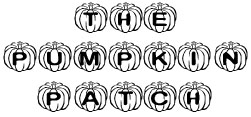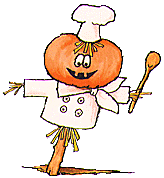|
Click here for Site Menu

By Shenanchie
for Food Fare

Autumn is my favorite time of year. I
have no qualms about stating I hate the summer months (I truly do), and look
forward to the first flush of autumn leaves. With autumn
comes Halloween and all of its associated traditions. However, this is not an
article about Halloween but rather the brilliant fruit known as the
pumpkin.
Pumpkins are used widely as a
Halloween decoration, but there are many other uses for the plump little
Jack O'Lantern. Just about every part of the pumpkin is edible (apart
from the stem), including the hollow shell which can be used as a serving dish. Recipes
associated with pumpkins are also wide and varied: one can make pies, cakes,
breads, tarts, Crème Brule, pudding, cookies, soup, butter, dips, pancakes,
cheesecake, ice cream, risotto and sauces. Pumpkins can even be baked like squash as
a side dish. The pumpkin seeds (to be found inside amongst the spaghetti-like
innards) can also be salted, roasted and served as a snack.
While I don't claim to be an expert
on pumpkin-lore, my brief article will attempt to shed some light on the edible
pumpkin, along with bits of history, planting and growing, varieties, methods of
cooking, health benefits, trivia, links and pumpkin-based recipes.

CONTENTS:
 History:
History:
References to the pumpkin date back many centuries. They are believed to have
originated in Central America, where seeds from related plants were found
dating as far back as 5500 B.C. The actual name pumpkin originated from the
Greek word pepon, which translated into a "large melon." The word
pepon was elaborated by the French (pompon)
and the English (pumpion). American colonists
changed it to pumpkin, and thus it has remained.
Native Americans used to dry strips of pumpkin to make floor mats. They also dried pumpkin for food. Indians called the pumpkin isqoutm
squash. American settlers soon adopted the orange globes, using
them in a wide variety of dishes from desserts to stews and soups. The colonists
made pumpkin pies by filling a hollowed-out shell with milk, honey and spices,
and then baking it. The leaves from the pumpkin plants were also used in salads,
with the flowers sometimes baked or fried. According to legend, pumpkins
were part of the first Thanksgiving feast in 1620.
The pumpkin also achieved mythical status with the legend of the Jack
O'Lantern. The particular tale revolves around Halloween, but came from
the Irish fable about a man nicknamed Stingy Jack. As the myth retells, Jack
invited the Devil himself to have a drink with him. In keeping with his
nickname, Jack did not want to pay for his drink so he convinced the Devil to
turn himself into a coin so that Jack could buy their drinks. Once the Devil did
so, Jack decided to keep the money and placed the coin in his pocket next to a
silver cross. The silver cross prevented the Devil from changing back into his
original form. Jack ultimately freed the Devil under the conditions that he not
trouble Jack for a year and should he die, not claim his soul. When Jack
eventually died, God would not allow him into heaven because of his unsavory
nature, and the Devil would not allow him into hell. The Devil sent Jack into
the dark of the night with only a burning coal to light his way. Jack placed the
coal into a hollow turnip, and has reportedly been roaming the earth with it ever
since.
The Irish once referred to the ghostly figure as "Jack of the Lantern" before
shortening it to Jack O'Lantern.
^Back to top^
 Planting & Growing:
Planting & Growing:
 Pumpkins are
tender, warm-season fruits. Pumpkin seeds do not germinate
well in cold soil.
Quite often seedlings are wounded by frost. Seeds should be planted only when
all danger of a frost has passed, and the soil has had a chance to warm.
Planting pumpkins for Halloween should occur from late May in the north, and
early July in southern American locations. Note: If pumpkins are
planted too early, they could soften and rot before Halloween rolls around. Pumpkins are
tender, warm-season fruits. Pumpkin seeds do not germinate
well in cold soil.
Quite often seedlings are wounded by frost. Seeds should be planted only when
all danger of a frost has passed, and the soil has had a chance to warm.
Planting pumpkins for Halloween should occur from late May in the north, and
early July in southern American locations. Note: If pumpkins are
planted too early, they could soften and rot before Halloween rolls around.
Pumpkins that vine require fifty to one hundred feet per hill. Plant seeds one inch deep,
with four or five seeds per hill. Make sure there is five to six feet between
hills, spaced in rows of ten to fifteen feet apart. When plants are established,
thin each hill to the best of two or three plants. Semi-bush pumpkin varieties
need to be planted one-inch deep, with four or five seeds per hill. Thin to the
best two plants per hill, allowing four feet between hills and eight feet
between rows. Miniature varieties of pumpkins should be planted one inch deep,
with two or three seeds every two feet in a row. Plant bush varieties one inch
deep (one or two seeds per foot of the row). Thin to one plant every three
feet, allowing four to six feet between rows.
Pumpkin plants should be kept clear of weeds on a regular basis, either by hoeing
or shallow cultivation. Pumpkins will need to be irrigated if a dry period in
the season occurs, although they tolerate hot weather rather well. If
insecticides are used, they should be administered only in the late afternoon or
early evening when the pumpkin plant blossoms are closed for the day. Bees
pollinate the flowers as well, so it is safer to apply insecticides after
the flowers close so the bees are not killed. As new blossoms appear every
day and bees land inside the open flowers, they will be safe from contact with
any deadly sprays.
Pumpkins should be harvested when they have attained a deep, solid color (orange
for the majority of varieties), and when the rind feels hard. Harvesting
usually occurs in late September or early October before heavy frosts begin. If
the pumpkin vines die early from disease, harvest the mature globes and store
them in a temperate, dry place until ready to use. When cutting pumpkins
from the vines, wear gloves to avoid pricks from the stems. Use pruning
shears or a sharp knife, leaving four inches of the stem attached.
Snapping the vines can result in broken stems (or "handles"). Pumpkins without
stems do not keep well. Try to avoid bruising or cutting the pumpkins while
handling them.
^Back to top^
 Pumpkin Varieties:
Pumpkin Varieties:
There are many varieties and sizes of pumpkins. The tables below give a brief
summary of the variations:
Small Orange Small (2 to 8 pounds)
|
Baby Bear
Small, flat
shape; fine stem |
|
Baby Boo
Turns a pale yellow at maturity |
|
Baby Pam (or
Oz)
Hybrid,
smooth skin, immature yellow color,
heavy stem, semi-bush |
|
Buckskin
Large vine; looks like a buff-colored
acorn |
|
Casper
Smooth, white-skinned pumpkin |
|
Cinderella
(Rouge d'Etampes)
From France, a flat pumpkin with ridged
fruit |
|
Jack-B-Little
Miniature pumpkin for decoration |
|
Jack-B-Quick
Ribbed and smaller than Jack-B-Little |
|
Munchkin
Miniature pumpkin, mainly for autumn
decorations |
|
Peek-A-Boo
Small pumpkin with long, dark green
handles |
|
Small Sugar
(or New England Pie)
Standard
pie-type pumpkin |
|
Spookie
Cross between Sugar Pie and Jack O'Lantern |
|
Spooktacular
Hybrid,
ribbed, strong stem, bright orange |
|
Sugar Treat
Hybrid,
bright color, semi-bush |
|
Trickster
Deep orange with a sturdy handle |
|
Winter
Luxury
Netted skin,
good for cooking |
Standard Orange Medium (8 to 15 pounds)
|
Autumn Gold
Hybrid,
yellow when immature, turns orange early
in growing season |
|
Frosty
Hybrid,
smooth skin texture |
|
Funny Face
Hybrid,
semi-bush |
|
Ghost Rider
Large with a
sturdy handle |
|
Harvest Moon
Hybrid;
mid-sized pumpkin |
|
Jack Of All
Trades
Dark orange
color with smooth sutures |
|
Jack
O'Lantern
Smooth-skinned with thick, yellow flesh,
roundly uniform |
|
Jackpot
Medium-sized, good for pies and carving |
|
Spirit
Hybrid,
semi-bush, good for pies and carving |
|
Trick or
Treat
Orange
color, naked seeded, good for pies |
|
Triple Treat
Seeded pie
pumpkin without a hull |
|
Wizard
Dark orange
with a smooth texture and light ribbing |
|
Young's
Beauty
Dark orange
with a hard skin |
Standard Orange Large (15 to 25 pounds)
|
Aspen
Deep orange,
large |
|
Big Autumn
Hybrid,
yellow when mature |
|
Connecticut
Field
Used for
canning, carving and stock feed |
|
Gold Rush
Deep orange
color , thick flesh with long handles |
|
Gold Strike
Dark orange
color, dark ribbing and handles; similar
to but lighter than Howden |
|
Half Moon
Tall and
thick-fleshed |
|
Happy Jack
Dark orange
with a sturdy handle |
|
Howden Field
Industry
standard for Jack O'Lantern's |
|
Jumpin' Jack
Dark orange,
large and heavy |
|
Mammoth Gold
Medium-orange color, with slightly ribbed
fruit |
|
Mother Lode
Large with
sturdy handles, similar to Jumpin' Jack |
|
Pankow's
Field
Large and
variable, with extremely large and long
handles |
Standard Orange Extra Large (25 to 60 pounds)
|
Appalachian
Dark orange
color, sturdy handles |
|
Aspen
Rich orange
color; medium ribs and sturdy handles |
|
A&C Hybrid
#300
Dark orange
in color, dark rind, sturdy handles and
smooth fruit |
|
A&C Hybrid
#500
Bright
orange in color, round fruit with deep
ribs, sturdy handles |
|
A&C Hybrid
#510
Deep orange
color round-to-tall shape, deep ribs |
|
Big Autumn
Similar to
Autumn Gold (big brother) |
|
Earl Autumn
Medium-deep
orange in color, similar to Autumn Gold |
|
Howden
Biggie
Deep orange
color, related to but larger than Howden |
|
Prizewinner
Hybrid,
medium-orange in color, sturdy |
Standard Orange Giants (50 to 900 pounds)
|
Big Moon PVP
Very large
show pumpkin |
|
Bix Max
Large carver |
|
Dill's Atlantic Giant
Frequently a
contest winner at pumpkin shows |
^Back to top^
 Methods of Cooking:
Methods of Cooking:
Besides being decorative during All Hallows Eve, pumpkins can be cooked in a
variety of different ways. Some of the more common
methods of cooking pumpkin are:
 Boiling or
Steaming Boiling or
Steaming
The pumpkin needs to be cut into
rather large pieces, and then rinsed in cold water. Place the pieces in a
large pot with a cup of water (it is not necessary for the water to cover
the pumpkin). Cover the pot and boil until tender, about twenty or thirty
minutes. If steaming the pumpkin, steam-time averages twelve to fifteen
minutes. You can check for doneness by inserting a knife or fork into the
flesh. If either slides in easily, the pumpkin is cooked. Boiled or
steamed pumpkin can be eaten as is, or seasoned with salt, pepper or butter
(similar to squash).
 Baking Baking
Baking pumpkin is again similar
to the preparation of squash. Cut the pumpkin in half, clearing away the
seeds and spaghetti-strings. Rinse thoroughly under cold water. Place the
pumpkin (cut side down) on a large baking sheet. Bake at 350-degrees F
for about one hour, or until the flesh is fork tender.
 Microwave Microwave
Halve the pumpkin, and place
cut-side down on a microwave-safe plate. Cook on high for about fifteen
minutes, checking for doneness. Cook longer if necessary.
 Puree Puree
Cook the pumpkin by any of the
methods listed above, waiting until the flesh has cooled. Remove the rind
using a sharp knife, separating carefully with your fingers. Place
the peeled pumpkin in a food processor and puree until smooth. Side Note:
Pureed pumpkin freezes rather well, especially in one cup portions. Frozen
pumpkin will keep for up to one year. Additionally, pumpkin puree can be
used to make pies, soups, cookies and breads.
 Roasted Roasted
Pumpkin seeds can
be salted and roasted, and then eaten as a snack.
^Back to top^
 Health Benefits: Health Benefits:
Pumpkins are low in fat.
They do not include added salt, sugar or flour. Pumpkins are also
low in calories and full of vitamins. One cup of boiled and drained pumpkin without additives contains:
-
Calories: 50
-
Carbohydrates: 12
grams
-
Cholesterol: 0
-
Dietary Fiber: 3
grams
-
Calcium: 37 mg
-
Magnesium: 22 mg
-
Fat: Less than one
gram
-
Potassium: 564 mg
-
Protein: 2.5 grams
-
Vitamin A: 310% of
RDA
-
Vitamin C: 20% of
RDA
The bright orange color
of pumpkin is indicative of a large amount of beta-carotene, which is one of the
plant cartenoids that converts to Vitamin A in the human body. Current research
claims that a diet containing foods rich in beta-carotene may reduce the risk of
developing various types of cancer, protects against heart disease, and some of
the degenerative facets of aging.
^Back to top^
 Recipes: Recipes:
^Back to top^
 Trivia: Trivia:
-
Pumpkin flowers are
edible.
-
The largest pumpkin
pie ever baked was more than five feet in diameter and weighed over 300
pounds. The pie used 80 pounds of cooked pumpkin, 36 pounds of sugar, 12
dozen eggs and required six hours to bake.
-
Pumpkins are 90%
water.
-
In 1584, French
explorer Cartier landed in North America and found what he called "gros
melons." It was translated into "pompions," which eventually became
"pumpkin."
-
Pumpkins in colonial
times were often used as an ingredient for the crust of the pies, not the
filling.
-
The largest recorded
pumpkin grown to date weighed 2,009 pounds, displayed by Ron Wallace at the
Topsfield Fair in Rhode Island in 2012.
-
Pumpkins are low in
fat and calories, and are good sources of Vitamins A and B, as well
potassium, protein and iron.
-
About 80% of the
pumpkin supply in the United States becomes available in October.
-
Native Americans
used pumpkin seeds for food and medicine.
-
Pumpkins were once
used as a remedy for snake bites.
-
Pumpkins are fruits!
-
Pumpkins, gourds and
other varieties of squash are all members of the vine crops Cucurbitacae family,
which also includes cucumbers, gherkins and melons.
^Back to top^
 Pumpkin Links: Pumpkin Links:
To learn more about
pumpkins, try one of the following links:
The Pumpkin Nook
The Pumpkin Master
Pumpkin Patch
Ohio Valley Giant Pumpkin
Growers
 Credits & Terms of Use:
Credits & Terms of Use:
(C) Shenanchie
(aka
Deborah
O'Toole)
For Ambermont Magazine
Reprinted exclusively for Food Fare
"The Pumpkin Patch" was written for entertainment purposes only and
expresses the sole opinions and observations of the author. This article is
not meant to be a historical essay on pumpkins, but rather a short piece
about the generalities of the popular fruit, along with growing information,
varieties, methods of cooking, health benefits, recipes, trivia and other
links of interest.
Feel free to use the material in this article as reference, but if direct
wording or quotes are used, proper credit would be appreciated.
Thank you.
Reference material and/or excerpts from "The
Pumpkin Patch" by Shenanchie at Food Fare linked to:
http://deborahotoole.com/FoodFare/pumpkinpatch.htm
To send Food Fare a comment or question about this article, click
here.

Halloween Cuisine:
 Food
Fare provides the e-book edition of All Hallows Eve,
Halloween and The Pumpkin
Patch in
one volume as part of the
Food Fare Culinary Collection. Food
Fare provides the e-book edition of All Hallows Eve,
Halloween and The Pumpkin
Patch in
one volume as part of the
Food Fare Culinary Collection.
Halloween Cuisine
contains a brief history of Halloween, traditions celebrated around the globe,
famous ghoulish legends, haunted domains, pumpkin information and trivia,
Halloween recipes, common Halloween words and their origins, and links for
further study.
The Kindle and Nook
editions of Halloween Cuisine contain bonus recipes
and information. If preferred, the online articles are still freely available
for reference.
Click here for more information.
Food Fare Site Menu:

Pumpkin Cook image:
Webweaver Clipart
^ Back to top of page ^
|